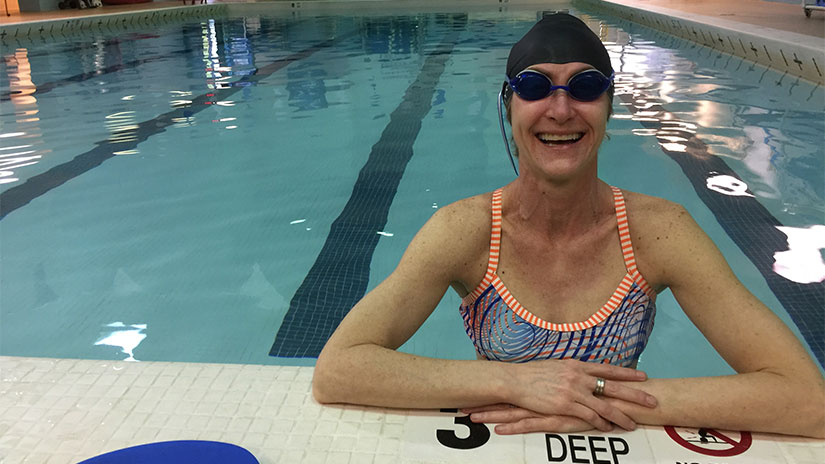
Loading Article
Strategy Takes to the Pool

I’ll never forget my inaugural Masters swim meet. I stood on the blocks before my first event—the 50-yard freestyle—and sized up my competition. To my left was a 62-year-old woman in a red technical suit, relaxed and smiling. To my right was an 77-year-old wearing a veil of concentration. Although I was new to the sport, I was in my early 50s and in pretty good shape, so I figured I had that heat in the bag.
At the other end of the pool, the meet organizer flashed me two thumbs up. Swim friends screamed my name. On the blocks a couple feet above the water, I felt on top of the world.
For all of two seconds, anyway.
I was about to discover that my perception of myself and my competitors was just that—an arbitrary and naive interpretation of reality. Had I prepared for the meet the way I typically advise businesses to approach marketing, my expectations might have borne a closer resemblance to the outcome.
What I should have known about my brand.
Sure, I’d been practicing, logging miles in the pool every week. But had I conducted a strategic analysis before the meet, it would have been clear where I still needed work and how I was likely to perform.
In fact, here’s what a SWOT of My Swimmer Self would have revealed:
Strengths
- Fit, athletic, tall (wide wingspan)
- Proficient freestyle and breast stroke
- Passion for the sport, highly competitive
Weaknesses
- Only been swimming for 3 years
- Erratic flip turns
- Feeble dolphin kick
- No practice diving off blocks
- Racing suit that was too big (creates drag)
Opportunities
- Competing against folks of all ages and skill levels
- Super-friendly, supportive environment
- Nice warm pool water (I have a history of hypothermia)
Threats
- 25-yard pool (short by competitive standards)
- Competitors with high school and college experience
- Fellow swimmers training with a Masters Club and coach
Clearly, in hindsight, the threat of experienced competition and my shortcomings in a pool requiring lots of turns were considerable enough to douse any dreams I might have had about winning.
But without this insight, I looked out over the pool feeling like an Olympian. Then came the blast of the starter’s horn.
What I should have learned about my competition.
Rule number one in marketing: Never, never, underestimate your competitors based on what you think you know about them. The swimmers who strolled onto the pool deck that day weren’t Katie Ledecky or Michael Phelps, but that didn’t mean they weren’t masters.
The meet kicked off with a 200-yard butterfly. I was astonished to see men in their 60s, 70s and 80s fly off the blocks and make quick work of a challenging stroke over a grueling distance.
Then I met a woman 10 years my senior (and about a foot shorter) who’d be swimming against me. She’d been competing for 20 years and trained every day with a club in Manhattan. She said working with a coach was essential to swimming faster and suggested that without regular speed work, my technique might fall apart in races.
And boy, was she right. My technique blew up like one of Letterman’s pumpkins hitting the pavement.
First, I dove in way too deep off the blocks. As a result, I wasn’t anywhere near the surface when I started swimming and the drag nearly stopped me dead. Then, on the flip turn, I skidded off the wall and found myself in the next lane before correcting my course. All of which amounted to lots and lots of lost time.
Meanwhile, The Woman Who Knew Whereof She Spoke had a flawless race. She beat me by four seconds, but it might as well have been four hours.
I dunked my head under the water in the cool-down lane to conceal my chagrin. That’s when I realized that, even though my competition may have been older, they were far more experienced and exceedingly well prepared.
What I should have understood about my audience.
It struck me, hard, that in order to be more competitive, I was going to have to reconsider my goals, training and even my reason for racing.
Was I competing for the sake of community—seeking camaraderie among people who shared a similar passion? Or did I have aspirations to win a national title in my age group one day? After all, If I wasn’t clear about my goals, how could I expect to define and achieve success?
At the conclusion of the meet, I’d finished four events, logged respectable times for a newbie, met some wonderful people and been inspired to continue competing. I’d also decided to make huge changes in the way I approach the sport.
Stop by the pool around lunchtime and you’ll find me doing speed work against a clock.
To come out ahead, you have to be strategic.
In marketing—as in swimming—success is about fundamentals and execution. Staying on top of your game is the best defense against competitors.
Here are three ways to make sure you’re always ready for action:
- Discover the truth about your brand and build on it. Maximize strengths, minimize weaknesses and take advantage of every opportunity. (Get a racing suit that fits.)
- Constantly scout the competition. Find out how they practice. Watch what they eat. Note what they wear. (For heaven’s sake, don’t be fooled by age in the pool.)
- Understand your priorities. It’s critical to achieving success. If you know where you’re headed, you can always set a course to get there. (Remember to practice your flip turns.)
While I’m still not setting the pool water on fire with newfound speed, I have begun to apply strategic thinking to my swimming. At a recent meet I shaved seconds off my previous times, bringing me a lot closer to my goal!
What about you? Do you have examples about how purpose and planning make life—or marketing—more rewarding?






































Comments (0)